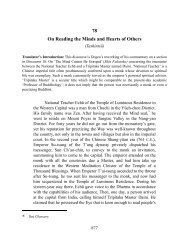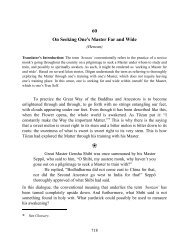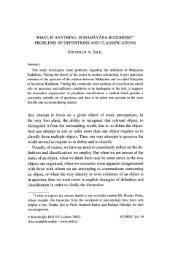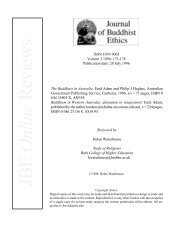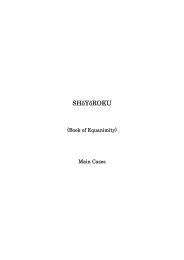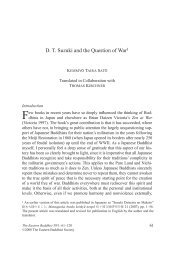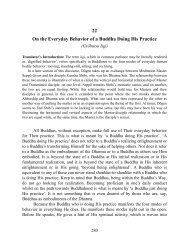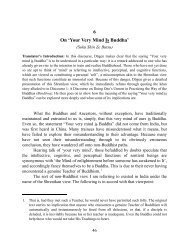Sansui Kyo - thezensite
Sansui Kyo - thezensite
Sansui Kyo - thezensite
- No tags were found...
You also want an ePaper? Increase the reach of your titles
YUMPU automatically turns print PDFs into web optimized ePapers that Google loves.
13On the Spiritual Discoursesof the Mountains and the Water(<strong>Sansui</strong>kyō)Translator’s Introduction: If readers are not already familiar with the Zen Buddhist use ofmetaphorical language, they may find the following comments useful in grasping what Dōgen istalking about in this Dharma discourse, which is baffling if its terms are taken only in their literalsense.It has been said that when the Sanskrit word dhyāna, meaning ‘meditation’ in the ZenBuddhist sense, was introduced into China, the Chinese had no word that was its equivalent, sothe Sanskrit word was spelled out by using two Chinese characters according to theirpronunciation: chan-na (pronounced like English ‘john-nah’). Over time, the term was shortenedand the Mandarin pronunciation altered slightly to ch’an (pronounced like ‘tchahn’). In Japan,this character was pronounced as zen. Although there were other Chinese characters that hadalready been used for transliterating the Sanskrit sound dhyā, the one chosen in the presentinstance also carried an ancient meaning, one relevant to Dōgen’s discourse: ‘to bow respectfullyto mountains and flowing water’.In the present discourse, Dōgen takes up the difference between the general, conventional useof the terms ‘mountain’ and ‘(flowing) water’ and their special use by the Chinese Zen Mastersfor pointing to spiritual matters. As previously indicated in notes to Dōgen’s earlier Dharmadiscourses, the term ‘mountain’ has several implications in Zen contexts. In this discourse inparticular, ‘mountain’ is most often used as a descriptive epithet for one who is sitting inmeditation, as still as a mountain among mountains (that is, one who is training among othermembers of the Buddhist Sangha), as well as for a wise and saintly person whose path has ledhim or her to seek a spiritual abode in a mountain, in both a literal and a figurative sense. Hence,the Chinese Zen Masters are referred to as ‘mountains’, and because their training never comesto an end but is ever green, they are referred to as ‘verdant mountains’. And because they are notrigid or static in their practice, they are sometimes referred to as ‘flowing mountains’.One of the meanings of ‘water’, in the Zen sense, is ‘the Water of the Spirit’, that is, BuddhaNature in general as well as one’s own Buddha Nature. In this translation, the use of this term isrendered as ‘the Water’ where context makes the meaning unambiguous. Someone’s ‘walking onthe water’ is thus descriptive of that person’s doing his training and practice by following theever-shifting, ever-flowing path of Buddha Nature.Dōgen does not always signal which of the various meanings of ‘mountain’ and ‘water’ heintends, but often keeps his references fluid. Thus, as with his Discourse 11: On ‘Just for theTime Being, Just for a While…’ (Uji), readers may find it worthwhile to read this chapterthrough twice, once referring to the footnotes to get the immediate sense, and then just reading itto experience the flow.141
Shōbōgenzō: On the Spiritual Discourses of the Mountains and the Water 142The ‘mountains and water’ of which I am speaking at the present momentare a manifestation of the words and ways of former Buddhas. 1 Both terms,residing in their place within the Dharma, have completely fulfilled their functionfor these Buddhas. Because these words signify conditions that actively exist in thetime periods before these Buddhas disappeared into the realm of spiritualEmptiness, 2 they refer to something that exists here and now, and because theysignify the Self before any sign of these Buddhas’ existence has appeared, theytranscend anything that manifests before our very eyes. The various spiritual meritsof the mountains are so vast and far reaching that the merits from our practice of‘riding the clouds’ will certainly be attained because of the mountains. 3 Thewondrous effects from our ‘going on with the wind to our back’, beyond doubt,will liberate us, thanks to the mountains. 4 ❀The monk Dōkai of Mount Daiyō, in instructing his assembly, said, “Theverdant mountains are constantly moving on, and the Stone Maiden, in the dark ofnight, gives birth to Her Child.” 5 The mountains are never lacking in the spiritual1. That is, ‘mountains’ and ‘water’ are not only terms used by previous Masters but also, asmetaphors, can embody the way in which these Masters functioned.2. Rev. Master Jiyu-Kennett often referred to this ‘emptiness’ as “the fullest emptiness you canever experience.” She herself used the term ‘the Immaculacy of Emptiness’ to describe It ina way that did not contain a connotation of a negative and ‘devoid’ sort of emptiness.3. ‘Riding the clouds’—originally, a Taoist term—refers to rising to higher levels. Here, itprobably refers to trainees realizing higher spiritual levels, thanks to the Buddhas and theAncestors, as well as to one’s fellow trainees.4. ‘Going on with the wind to our back’—another Taoist term—refers to being supported by afavorable tailwind, again, probably to be understood as spiritual help and support from theSangha.5. To paraphrase the first half, Buddhist Masters who are literally, or figuratively, always‘sitting’ in meditation (the mountains) and whose training and practice is ‘alive’ (verdant)are constantly moving on (or, more literally, ‘progressing apace’), ‘always becomingBuddha’. The second phrase has multiple meanings which arise from the resonance of thesaying. For example, on one level, the epithet ‘The Stone Maiden’ refers to That Which Is,from which all things arise, without having to depend on any external ‘impregnating’ agentand without the process being visible (happening ‘in the dark of night’). On another level,the Stone Maiden refers to the trainee whose intent to realize Truth is active, but whosemind is as hard as rock. Yet, despite this hardness, it will, through training, crack open, andthe Child of Enlightenment will be born.
Shōbōgenzō: On the Spiritual Discourses of the Mountains and the Water 144Dharma of the Buddha would not have reached us today. Stepping forward has notceased, nor has stepping back. When there is a stepping forward, it does not standin opposition to stepping back; when there is a stepping back, it does not stand inopposition to stepping forward. We characterize this as ‘the mountain’s flowing’ oras ‘the flowing mountain’.Because a verdant mountain trains in order to master ‘moving on’ and Enōlearned through practice to ‘go walking upon the Water’, 7 your learning thesethings through your practice is synonymous with a mountain’s learning themthrough practice. Without the mountains’ altering their body or mind, they havebeen going all around and about, learning through practice, with the look of amountain about them.Do not slander the mountains by saying, “Verdant mountains are incapableof moving on,” or “No mountain to the east of us is capable of walking uponwater.” It is because of the baseness of some people’s views of things that theydoubt the phrase ‘mountains walk on’, just as it is due to their inexperience andscant knowledge that they are startled by the words ‘a flowing mountain’.Nowadays, although we may say that they have not thoroughly explored even thephrase ‘flowing water’ in all its varied meanings, it is actually just a matter of theirbeing immersed in pedestrian views and drowning in ignorance. As a result, theytake as their form and name, or as their very lifeblood, whatever they esteem astheir ‘cumulative qualities’. Its walking on exists; its flowing exists. There is a timewhen a mountain gives rise to the Child of the Mountain. In accordance with theprinciple that a mountain becomes an Ancestor of the Buddha, the Ancestors of theBuddha have made Their appearance in this manner.When people have eyes before which a mountain is manifesting as grass andtrees, earth and stones, or walls and fences, they do not doubt what they see nor arethey disturbed by it, and it is not the whole of what is manifesting. Even though atime may occur when a mountain appears to them as being adorned with the SevenTreasures,* this is not the real refuge. Even if they see manifesting before them therealm in which all the Buddhas are carrying out the Way, it is never a place to cravefor. Even if they have above their heads the sight of a mountain manifesting theindescribable spiritual virtues of all the Buddhas, Truth is not limited merely to7. This phrase would be conventionally translated as ‘The mountain to the east of us goeswalking upon water’, but the reference is actually to a well-known Zen saying that Dōgendiscusses later, “Tōzan goes walking upon the Water.” Tōzan (‘The East Mountain’) was anepithet for the Sixth Chinese Ancestor Daikan Enō; it is unrelated to the name Tōzan,meaning ‘Cave Mountain’, by which several other monks are known, such as Tōzan Ryōkai.
Shōbōgenzō: On the Spiritual Discourses of the Mountains and the Water 145this. The fully visible manifestation of each and every thing is the physical body ofeach and every thing along with the environment in which it exists. So, such viewsas those above are not to be taken as the manner in which Ancestors of the Buddhaput the Way into practice: they are merely what people can see when lookingthrough a hollow straw.Splitting ‘subjective’ mind apart from ‘objective’ environment is what theGreat Sage Shakyamuni warned us about; intellectually expounding on ‘mind’ orexpounding on ‘nature’ is not something that Ancestors of the Buddha undertake.Having theories about mind or about nature is a profession for those who are apartfrom the Buddhist Way; to be bogged down in words and phrases is not speech thatleads to liberation. There is a state that is free from such conditions as these. It hasbeen described as “The verdant mountains are constantly moving on,” and as “Enōwent walking upon the Water.” You need to explore this state in the greatest detail.❀The statement “The Stone Maiden, in the dark of night, gives birth to HerChild” refers to the time when the Stone Maiden gives birth to Her Child as ‘in thedark of night’. Generally speaking, there are stones that are male and stones thatare female, as well as stones that are neither male nor female, and all of these quitenicely fill up the heavens and fill up the earth. And there are heavenly stones andthere are earthly stones, which those who wander without a preconceived goalspeak of, though persons who really know them are rare indeed. 8One needs to understand the principle of Her ‘giving birth to a Child’. At thetime of Her giving birth to the Child, are Parent and Child made separate? Youmust devote yourself to exploring through your training not only that ‘the Childbecoming the Parent’ is the full manifestation of ‘giving birth to the Child’, butalso that ‘the time when the Parent becomes the Child’ is the full manifestation of‘giving birth to the Child’. You must thoroughly penetrate what is being said here.❀Great Teacher Ummon Bun’en once said, “Enō went walking upon theWater.” The meaning of what is fully manifested through these words is that all8. To paraphrase one level of meaning, male and female stones refer to those who are ‘StoneMaiden’ trainees as explained in footnote 5. These ‘stones’, as well as conventional stones,occur in both heavenly and earthly worlds. Though people may speak of spirituallydeveloped beings as heavenly (‘beings spiritually beyond me’) or as earthly (‘real people’),those who can actually distinguish between them are rare indeed.
Shōbōgenzō: On the Spiritual Discourses of the Mountains and the Water 146mountains are Enō, and every Enō goes walking upon the Water. This is why thisAncestor of the Buddha fully manifested Mount Sumeru amidst the ninemountains, and fully realized It through his training, along with realizing otherthings as well. 9 People call him Enō. But how could there possibly be the slightestgap between Ummon’s and Enō’s Skin and Flesh, Bones and Marrow, or betweenUmmon and his living within his own realization through training?❀In the nation of Great Sung China today, there is a certain type of unreliableperson that has now grown to be quite a crowd. They have gotten to the pointwhere they cannot be bested by the few true people. This bunch says such things asthe following:Just like the comments about Enō’s walking on water or the oneabout Nansen’s buying a scythe, what is being said is beyond anythingthat reason can grasp. In other words, any remark that involves the useof intellect is not the Zen talk of an Ancestor of the Buddha, whereas aremark that goes beyond anything that reason can handle is whatcomprises a ‘remark’ by an Ancestor of the Buddha. As aconsequence, we would say that Meditation Master Ōbaku’s applyinga stick to his disciples or Meditation Master Rinzai’s giving forth witha loud yell go far beyond rational understanding and do not involvethe use of intellect. We consider this to be what is meant by the greatawakening to That which precedes the arising of any discrimination.The reason why the ancient virtuous Masters so often made skillfuluse of verbal phrases to cut through the spiritual entanglements oftheir disciples was precisely because these phrases were beyondrational understanding.Fellows who talk like this have never met a genuine teacher, nor do theyhave an eye for learning through training. They are foolish puppies who are noteven worth discussing. For the past two or three centuries in the land of SungChina, such devilish imps and ‘little shavers’ like the Gang of Six have beenmany. 10 Alas, the Great Way of the Buddha’s Ancestors has become diseased! This9. A reference to the eight symbolic concentric rings of mountains with Mount Sumeru as theircenter, a metaphor for having achieved a full centering of oneself within one’s meditation.10. ‘The Gang of Six’ refers to six monks during the Buddha’s time whose wayward behaviorprompted the framing of monastic rules and regulations. ‘Little shavers’ was a term applied
Shōbōgenzō: On the Spiritual Discourses of the Mountains and the Water 147explanation of those people cannot compare even with that of the shravakas * whofollow the Lesser Course;* it is even more confused than that of non-Buddhists.These fellows are not laity nor are they monks; they are not gods or humans. Andwhen it comes to exploring the Buddha’s Way, they are more befuddled thanbeasts. The stories which the ‘little shavers’ refer to as going beyond anything thatreason can grasp only go beyond anything their reason can grasp: it was not thatway for any Ancestor of the Buddha. Just because they said that such stories arenot subject to rational understanding, you should not fail to learn through yourtraining what the intellectually comprehendible pathways of the Ancestors of theBuddha are. Even if these stories were ultimately beyond rational understanding,the understanding that this bunch has cannot hit the mark. Such people are in greatnumber everywhere in Sung China, as I have personally witnessed. Sad to say, theydid not recognize that the phrase ‘the use of intellect’ is itself a use of words, norrealize that a use of words may liberate us from the use of our intellect. When Iwas in Sung China, even though I laughed at them for their foolish views, they hadnothing to say for themselves; they were simply speechless. Their present negationof rational understanding is nothing but an erroneous view. Who taught them this?Even though you may say that they have not had someone to teach them of the truenature of things, nevertheless, the fact remains that, for all intents and purposes,they still end up being offspring of the non-Buddhist notion that things arisespontaneously, independent of any form of causality.❀You need to recognize that Enō’s walking on the Water is the Bones andMarrow of the Buddhas and Ancestors. Various kinds of water manifested underEnō’s feet. This is why various mountains ride the clouds or tread the heavens.Above the crests of various types of water are various types of mountains which gowalking up and down on the Water. As the various mountains go walking throughthe various types of water, the tips of their feet often make the water dance; thus,their walking may go seven steps in one direction or eight in another. 11 That is,there is no time when training and enlightenment do not exist.to monks who shaved their heads so that they could partake of monastic food and lodging,but who had no interest in spiritual training.11. That is, ‘mountains’ are able to move about freely in their daily training.
Shōbōgenzō: On the Spiritual Discourses of the Mountains and the Water 148❀As for the Water, It is neither strong nor weak, nor is It wet or dry, nor doesIt move or stay still, nor is It cold or hot, nor does It exist or not exist, nor is Itdeluded or awakened. When frozen solid, It is harder than a diamond, so who cansmash It? When melted, It is more yielding than diluted milk, so who can tear It tobits? This being so, we cannot doubt the qualities of the various forms of existencethat manifest before our very eyes.For now, just concentrate on learning to recognize, through your training, themoments when you are able to open your eyes and see the Water in the wholeuniverse as the Whole Universe. And ‘learning through training’ does not refer justto the times when ordinary people or those in loftier positions see the Water; thereis your learning through training in which the Water sees the Water. Because theWater puts the Water into practice in order to realize what the Water is, there willbe your thorough investigation of the Water’s expressing through words what theWater is. In this way, you will manifest the pathway upon which we ourselves meetour Self. Until then, you must go back and forth on that road of life upon whichothers are all involved with making a study of ‘other’, until you leap free.❀To speak in general, what people see as a mountain or as water differs invarious ways. There are those who, upon catching sight of what I am calling ‘theWater’, see It as a string of pearls, but they fail to see such a necklace as theWater. 12 They undoubtedly consider the form in which we humans perceivesomething as what the Water is. What they see as a pearl necklace, I see as theWater. And there are those who see the Water as a wondrous flower, but this doesnot mean that they are using an actual flower for the Water. Hungry ghosts,* uponencountering the Water, may see It as a raging inferno, or as thick, congealingblood. Dragons and other denizens of the deep may see It as a palace or as a statelymansion. Some may see It as the Seven Treasures or as the Wish-fulfilling Jewel, 13and others as various sorts of trees, or as fences and walls, and others as the12. For instance, they may see someone’s Buddha Nature as being a beautiful adornment, not asthat person’s true, innate nature.13. The Wish-fulfilling Jewel, sometimes called the Mani Jewel, refers to the Buddha Naturewhich is inherent in all living beings. Meditation Master Gensha Shibi called it “The OneBright Pearl”. Dōgen discusses this at length in Discourse 4: On ‘The One Bright Pearl’(Ikka Myōju).
Shōbōgenzō: On the Spiritual Discourses of the Mountains and the Water 149immaculate, liberated Dharma Nature, and others as someone’s True Body, andothers as someone’s physical appearance along with that person’s mental nature.When humans see the Water via any of these means, this can be the cause of theirliberation from commonplace ‘life’.Although what is seen may differ completely according to the one who seesIt, we should not be too hasty in accepting this as absolutely so. Are there really‘all sorts of ways’ of seeing any single object? Have you committed an error bytaking the plethora of images for what is actually one object? Then, at the verypeak of your efforts, you will need to make a further effort. If what I have just beensaying is so, then, likewise, there cannot be just one or two ways for training torealize the Truth and for assiduously practicing the Way, and the realm of theUltimate can be of a thousand kinds and ten thousand sorts.Further, when we think about the fundamental meaning of this, even thoughwe may say that the varieties of the Water are many, it may seem to some as ifthere were no one, fundamental Water or as though the Water had no variety. Thus,the various ways in which the Water appears do not depend on one’s mind or onone’s body, nor do they arise from one’s karma*-producing actions, nor do theydepend on oneself or on someone else: they possess that freedom from delusionwhich is dependent on the Water Itself. Thus, the Water is beyond being earth,water, fire, wind, space, or consciousness, beyond being blue, yellow, red, white, orblack, beyond being form, sound, odor, taste, sensations, or thoughts, and even so,the Water naturally manifests fully as earth, water, fire, wind, and so forth.Because this is the way things are, it would be difficult to say clearly whathas created our nation and its palaces as they appear before us today or to say whatthey will be made into. To say that they depend on the Wheel of Space and theWheel of Wind is not what is true for me or true for others, for it is the product ofspeculation based on the suppositions of a narrow outlook. 14 This view has beenasserted based on some people’s thinking that nothing could continue to exist if itdid not have some place to hang onto. The Buddha said, “All thoughts and thingsare ultimately free of any attachments, so there is no place where they permanentlyabide.” You need to keep in mind that even though all thoughts and things areinherently free of any attachments, they do have some place where they exist.14. According to an ancient Indian view, the universe is comprised of the five elements (referredto here as ‘Wheels’), with the more solid elements being dependent on the less solid, theWheel of Wind (i.e., gaseous matter) and the Wheel of Space being the least substantial.
Shōbōgenzō: On the Spiritual Discourses of the Mountains and the Water 150❀When human beings look at water, they only see it as something thatceaselessly pours out and flows on. This flowing has many forms, each being a partof the human perspective. It flows over the earth and out of the sky, now surgingupwards, now pouring downwards, streaming along in the bends of a river andcoursing through deep chasms. It rises up to make clouds and comes down to formpools.The Chinese scholar Wen-tsu once remarked, “It is the way of water to riseup to the heavens and become rain and dew, and to fall to earth and become riversand streams.” Today, those who wander in ignorance still speak in this manner. Itwould be most shameful for those who call themselves the offspring of theBuddha’s Ancestors to be more in the dark about the meaning of this than such folkas these, for what he is really saying is “The way of the Water is not something thatwater is aware of, yet water is fully capable of functioning, and it is not somethingthat the Water is not aware of, yet the Water is fully capable of functioning.”As Wen-tsu said, “It rises up to the heavens and becomes rain and dew.” Beaware that the Water ascends to ever so many lofty places in the heavens above toform rain and dew, and rain and dew take a variety of forms according to theworlds in which they appear. To say that there is some place that the Water does notreach is a teaching of the shravakas of the Lesser Vehicle or an erroneous teachingof non-Buddhists. 15 The Water extends into the tongues of fire, and into ourthoughts and deliberations and distinctions, and into our perceptions, and into ourBuddha Nature.Consider the statement, “It falls to earth and becomes rivers and streams.”When the Water descends to earth, It becomes rivers and streams. Some varieties ofrivers and streams frequently turn into wise, perceptive persons. In the opinion ofthe everyday stream of the ordinary and the befuddled, water is unquestionably thatwhich exists in rivers, streams, oceans, and seas. This is not so, for the rivers andseas have come into existence within the Water. Thus, there is the Water even inplaces where there are no rivers or seas. It is just that when the Water descends toearth, It creates the effect of ‘rivers and seas’.Also, do not work it out that, when there is some place where the Water hasformed rivers and seas, there are no social worlds or Buddhist lands. Even in asingle drop, immeasurable Buddhist lands manifest before our very eyes. Hence, it15. This is a reference to the mistaken notion of an icchantika, that is, someone who is believedto be totally devoid of Buddha Nature.
Shōbōgenzō: On the Spiritual Discourses of the Mountains and the Water 151is not a question of water existing within a Buddhist land or of a Buddhist landexisting in the Water. The existence of the Water is in no way dependent on thethree temporal worlds or on the worlds of thoughts and things. Even so, the Wateris the spiritual question that manifests before our very eyes. Wherever Buddhasand Ancestors go, the Water invariably goes. Wherever the Water goes, Buddhasand Ancestors invariably manifest. Because of this, Buddhas and Ancestors havealways regarded the Water as Their body and mind, as Their very thoughts.Since the preceding is so, there is no document within or outside Buddhismthat says that the Water does not run upwards. The path of the Water circulatesevery which way—up above and down below, far and wide. So, within BuddhistScriptures, it is said that fire and wind climb up above, earth and water go downbelow. This ‘up above and down below’ is something to investigate in particular.Consider carefully the ‘up above and down below’ of the Buddha’s Way. It meansthat the place where earth and water go is ‘down below’; it does not mean thatdown below is some ‘place’ where earth and water go. 16 Where fire and wind go isup above. Even though the universe of thoughts and things does not completelydepend on the measurements of the four directions, or upon up and down, wetemporarily fabricate our universe in accordance with the four, five, or sixelements. 17 The Heaven Beyond Deliberate Thought is not always ‘up above’; theHell of Incessant Suffering is not always ‘down below’. Incessant suffering is oneperson’s whole universe; being beyond deliberate thought is another person’swhole universe.Hence, when a dragon or a fish views water as a palace, it will not be like ahuman being seeing a palace, nor will such a creature perceive the water to besomething that is flowing on. Were some onlooker to say to the dragon or the fish,“Your palace is flowing water,” the creature would at once be startled and filledwith doubt, just as some of you may have been startled earlier when you heard itasserted that mountains flow like water. Further, it may be possible to maintain thata similar assertion can be made about the railings, steps, and pillars of palaces andmansions. Calmly consider this principle and keep turning it about in your mind,for if you do not learn how to go beyond these borderline expressions, you will notlet go of the body and mind of one who wanders in ignorance, or fully realize whatthe domain of the Buddhas and Ancestors is, or fully realize what the domain of16. That is, ‘down below’ refers to a direction, not to any specific place.17. The four elements are earth, water, fire, and wind; the five are the four elements plus space;the six are the five elements plus consciousness.
Shōbōgenzō: On the Spiritual Discourses of the Mountains and the Water 152those who wander in ignorance is, or fully realize what the palace of one whowanders in ignorance really is.Now, we humans may clearly perceive the very essence of the sea or thevery heart of a river to be water, but what sort of thing a dragon or a fish mayperceive to be water, or may make use of as water, we do not yet know. Do notfoolishly assume that other creatures make use of water in accordance with how weperceive water.Now, when we Buddhist trainees learn about the Water, we should notblindly cling to just the everyday, human view of water; we need to go on andinvestigate through our practice the Water of the Buddha’s Way. How we view theterm ‘Water’ as used by the Ancestors of the Buddha is something we need toinvestigate through our practice. We also need to investigate through our practicewhether or not the Water actually exists within the traditional families of theBuddha’s Ancestors.❀The mountain, from times immemorial, has served as the place of residencefor great saintly ones. Both the wise and the saintly have considered the mountainto be their innermost place and to be their body and mind. And thanks to the wiseand the saintly, mountains have manifested before our very eyes. People in generaltend to regard mountains simply as gathering places for ever so many great saintsand wise ones, but for those who enter a mountain, there will not be a single personwhom any of them will meet; only the natural functioning of a mountain willmanifest, and nothing more. And furthermore, no traces of their having entered willbe left behind.When someone with the perspective of the secular world encounters amountain, and when someone with the perspective of one amongst mountainsmeets this mountain, how their minds think of this mountain or how their eyes seethis mountain will be vastly different. The conventional human perception of‘something flowing’ and the conventional human perception of ‘something notflowing’ will not be at all like the perceptions of dragons and fish. Ordinary people,as well as those in lofty positions, strive to secure a place within their own sphere;other species may look upon this with suspicion, or may even give rise to doubtfulthoughts. Thus, you should investigate the phrase ‘mountains flow’ with theAncestors of the Buddha, and do not abandon the matter when you find yourselfsurprised or in doubt. Taken in one context, they flow; taken in another, they do notflow. One time round, they flow; another time round, they do not flow. If you do
Shōbōgenzō: On the Spiritual Discourses of the Mountains and the Water 153not investigate the matter in this way through your practice, it will not be theTathagata’s Wheel of the True Teaching.❀A former Buddha once said, “If you would avoid incurring unrelenting,hellish karma, do not malign the Tathagata’s Wheel of the True Teaching.” Youshould engrave these words on your skin, flesh, bones, and marrow; you shouldengrave them on the outer circumstances and inner conditions of your body andmind; you should engrave them on what is immaterial; you should engrave themon what is material. They have already been engraved on trees and on stones; theyhave already been engraved on both cultivated fields and places of humanhabitation.Generally speaking, we say that mountains belong to some country orregion, but it is to those who love mountains that they really belong. Invariably,when a mountain loves its Host, the lofty virtues of the saintly and wise enter themountain. When those who are saintly and wise dwell in the mountains, themountains belong to them; as a result, the trees grow luxuriant and bouldersabound, the birds are wondrous and the animals are surpassing fine. This isbecause they are under the influence of the virtues of one who is saintly and wise.You need to recognize that the truth of the matter is that mountains are fond ofthose who are wise, and that they are fond of those who are saintly.From the past to the present, it has been a good example for us that emperorshave often gone up a mountain to bow to a wise one and to respectfully question agreat saintly one. At such a time, they show their respect with all the formalitiesdue their teacher: they do not follow the ordinary ways of behaving towardspeople. When an emperor extends his loving influence over his subjects, he neveruses it to coerce mountain sages, for clearly, mountains are separate from the worldof human society. In the legendary times of the Chinese Flower Kingdom, on theoccasion when the Yellow Emperor paid a respectful visit to Kuang-cheng, whowas the guardian spirit on Mount Kung-tung, he crawled on his hands and knees,groveling obsequiously and begging the spirit for instruction.Also, once Shakyamuni Buddha had left the palace of His father the king,He entered the mountains. Even so, His royal father did not feel rancor towards themountains. Nor did His royal father distrust those in the mountains who wereteaching the prince. The twelve years that He trained in the Way were largely spentin the mountains. His realization as Lord of the Dharma also took place whilst inthe mountains. Truly, even universal monarchs whose chariot wheels rolleverywhere do not undertake to forcibly control the mountains.
Shōbōgenzō: On the Spiritual Discourses of the Mountains and the Water 154To be sure, a mountain is not the realm of ordinary folk, nor is it the realm ofthose who dwell in lofty places. You cannot really perceive what a mountain is bymeans of the standards used by those who wander in ignorance. If mountains arebeyond comparison with the everyday notion of ‘flowing’, who then, pray, candoubt that a mountain flows, and that a mountain does not flow, as well aswhatever else a mountain may do?And, from distant times, there have been wise ones and saintly ones whowere even wont to live on the water. Whilst living on the water, some caught fish,some caught humans, and some caught the Way. These are all in the traditionalmainstream of ‘being in the Water’. Along with this, there will be those who catchthemselves, those who catch the Hook, those who are caught by the Hook, andthose who are caught by the Way. Long ago, no sooner had the monk Tokujō lefthis Transmission Master Yakusan to go live at the heart of the river than he becameacquainted with the wise and saintly one of the Hua-tung River. 18 Was it not a fishhe hooked? Was it not a person he hooked? Was it not the Water he hooked? Was itnot someone from the Water he hooked? The one who can really ‘see’ Tokujō isTokujō. Tokujō encountering of That One is his meeting ‘the True Person’.❀Not only is there water in the world, there is a world within the world ofwater. Not only is it like this in water, there is also a sentient world in clouds, and asentient world in wind, and a sentient world in fire, and a sentient world in earth,and a sentient world in the realm of thoughts and things, and a sentient world in ablade of grass, and a sentient world in a monk’s traveling staff. Wherever there is asentient world, there is, of necessity, a world of Buddhas and Ancestors in thatplace. Such a principle should be well explored indeed! Hence, the Water is thevery palace of the True Dragon: It is beyond flowing or falling. If we recognize Itonly as something that flows, the word ‘flowing’ slanders the Water. One reasonfor this is that the use of the word forces It to be something not flowing. The Wateris simply the Water as It is, in and of Itself. It is the natural functioning of theWater as the Water and is beyond ‘flowing’. As soon as you penetrate through yourpractice both the flowing of a single drop of water and its non-flowing, thecomplete penetration of all thoughts and things will immediately manifest beforeyour very eyes. With mountains, too, there are mountains hidden within treasures,18. After Tokujō left his Master, he ferried a small boat across the river. He tried to teach Zen tothose boarding his ferry boat. He often lifted his oar out of the water and said, “Do youunderstand?” One of those whom he met in this way later became his Dharma heir.
Shōbōgenzō: On the Spiritual Discourses of the Mountains and the Water 155mountains hidden within marshes, mountains hidden within the sky, mountainshidden within mountains. And there is learning through practice that there aremountains which are hidden within That Which Is Hidden.The Old Buddha Ummon Bun’en once said, “Mountains are mountains;water is water.” What these words mean goes beyond saying that mountains aremountains: it is saying that Mountains are mountains. Therefore, you need toinvestigate Mountains through your practice. If you thoroughly investigateMountains in your practice, this will be your effort in the mountains. In this way,the Mountains and the Water will naturally produce the wise as well as the saintly.Given to the assembly at Kannondōri in Kōshōhōrin-ji Temple on the eighteenth day of the tenthlunar month in the first year of the Ninji era (November 3, 1240).I made this copy in the chaplain’s quarters at Kippō-ji Temple, Yoshida Province, EchizenPrefecture, on the third day of the sixth lunar month in the second year of the Kangen era(July 9, 1244).Ejō





